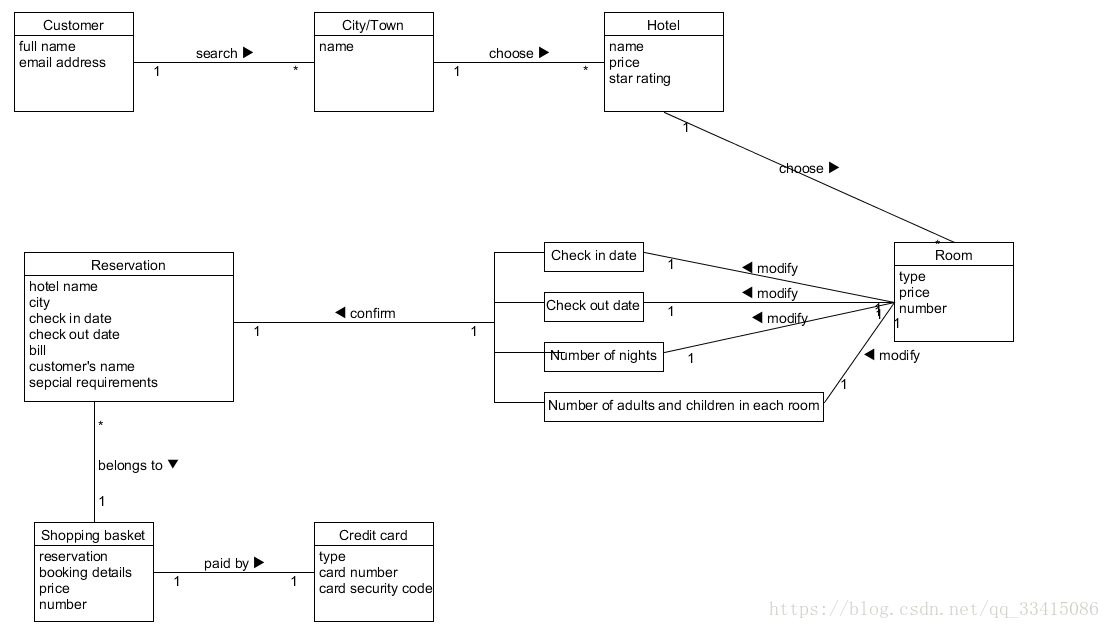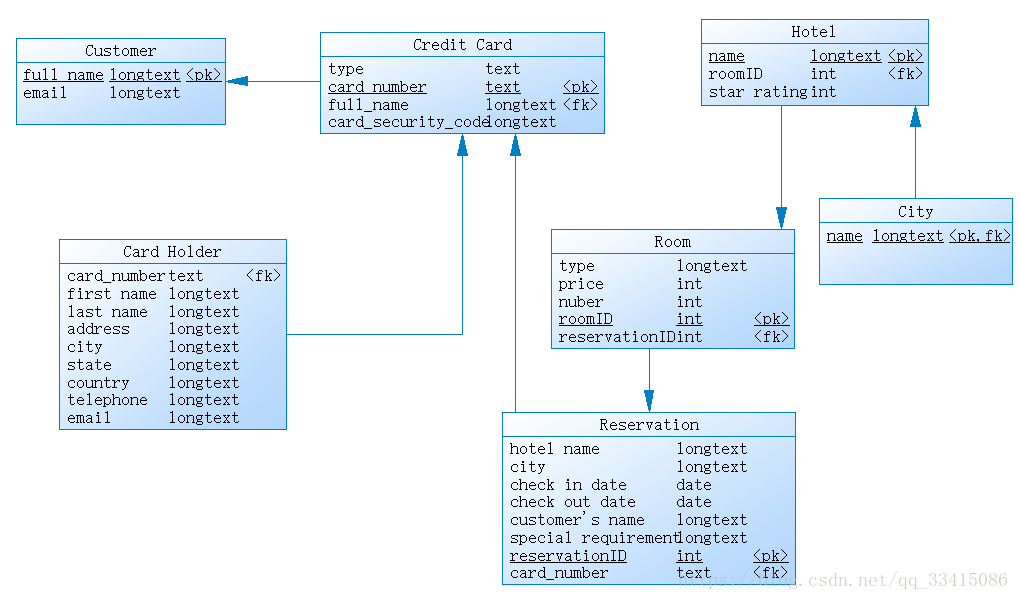领域建模
a. 阅读Asg_RH文档,按用例领域模型建模
- 按Task2 要求,请使用工具UMLet,截图格式务必是png并控制尺寸
说明:请不要受PCMEF层次结构影响。你需要识别实体(E)和中介实体(M, 也称状态实体)
(1)在单页面应用(如vue)中,E一般与数据库建模有关,M一般与store模式有关
(2)在java web应用中,E一般与数据库构建有关,M一般与session有关

b. 数据库建模(E-R模型)
- 按 Task 3 要求,给出系统的 E-R 模型(数据逻辑模型)
- 建模工具 PowerDesigner(简称PD) 或开源工具 OpenSystemArchitect
- 不负责的链接 http://www.cnblogs.com/mcgrady/archive/2013/05/25/3098588.html
- 导出 Mysql 物理数据库的脚本
- 简单叙说 数据库逻辑模型 与 领域模型 的异同
数据逻辑模型

Mysql 物理数据库的脚本
/*==============================================================*/
/* DBMS name: MySQL 5.0 */
/* Created on: 2018/4/29 22:31:12 */
/*==============================================================*/
drop table if exists "Card Holder";
drop table if exists City;
drop table if exists "Credit Card";
drop table if exists Customer;
drop table if exists Hotel;
drop table if exists Reservation;
drop table if exists Room;
/*==============================================================*/
/* Table: "Card Holder" */
/*==============================================================*/
create table "Card Holder"
(
card_number text,
"first name" longtext,
"last name" longtext,
address longtext,
city longtext,
state longtext,
country longtext,
telephone longtext,
email longtext
);
/*==============================================================*/
/* Table: City */
/*==============================================================*/
create table City
(
name longtext not null,
primary key (name)
);
/*==============================================================*/
/* Table: "Credit Card" */
/*==============================================================*/
create table "Credit Card"
(
type text,
card_number text not null,
full_name longtext,
card_security_code longtext,
primary key (card_number)
);
/*==============================================================*/
/* Table: Customer */
/*==============================================================*/
create table Customer
(
full_name longtext not null,
email longtext,
primary key (full_name)
);
/*==============================================================*/
/* Table: Hotel */
/*==============================================================*/
create table Hotel
(
name longtext not null,
roomID int,
"star rating" int,
primary key (name)
);
/*==============================================================*/
/* Table: Reservation */
/*==============================================================*/
create table Reservation
(
"hotel name" longtext,
city longtext,
"check in date" date,
"check out date" date,
"customer's name" longtext,
"special requirement" longtext,
reservationID int not null,
card_number text,
primary key (reservationID)
);
/*==============================================================*/
/* Table: Room */
/*==============================================================*/
create table Room
(
type longtext,
price int,
nuber int,
roomID int not null,
reservationID int,
primary key (roomID)
);
alter table "Card Holder" add constraint FK_Reference_2 foreign key (card_number)
references "Credit Card" (card_number) on delete restrict on update restrict;
alter table City add constraint FK_Reference_3 foreign key (name)
references Hotel (name) on delete restrict on update restrict;
alter table "Credit Card" add constraint FK_Reference_1 foreign key (full_name)
references Customer (full_name) on delete restrict on update restrict;
alter table Hotel add constraint FK_Reference_4 foreign key (roomID)
references Room (roomID) on delete restrict on update restrict;
alter table Reservation add constraint FK_Reference_6 foreign key (card_number)
references "Credit Card" (card_number) on delete restrict on update restrict;
alter table Room add constraint FK_Reference_5 foreign key (reservationID)
references Reservation (reservationID) on delete restrict on update restrict;
数据库逻辑模型与领域模型的异同
- 领域模型 是对领域内的概念类或现实世界中对象的可视化表示。
- 逻辑模型 介于概念模型和物理模型之间,具有物理模型的特性,在概念模型中的多对多关系,在逻辑模型中将会以增加中间实体的一对多关系的方式来实现。具体来说,逻辑模型中一方面显示了实体、实体的属性和实体之间的关系,另一方面又将继承、实体关系中的引用等在实体的属性中进行展示。
所以在领域模型中,并不会排除需求中没有明确要求记录其相关信息的类,也不会排除没有属性的概念类。根据概念模型可以生成逻辑模型,逻辑模型是概念模型的延伸,表示概念之间的逻辑次序,是一个属于方法层次的模型。 - 相同点:将需求抽象为可视化的概念关系
- 不同点:数据库逻辑模型是系统设计及实现的一部分,描述的是用户需求在技术上的实现方法。领域模型用于描述业务需求,帮助用户和需求分析人员更好地理解业务需求。







 本文探讨了领域建模和数据库建模的过程,包括如何识别实体及其关系,并使用UMLet和PowerDesigner等工具创建领域模型和E-R模型。通过实际案例展示了单页应用和Java Web应用中的实体建模差异。
本文探讨了领域建模和数据库建模的过程,包括如何识别实体及其关系,并使用UMLet和PowerDesigner等工具创建领域模型和E-R模型。通过实际案例展示了单页应用和Java Web应用中的实体建模差异。
















 263
263

 被折叠的 条评论
为什么被折叠?
被折叠的 条评论
为什么被折叠?








